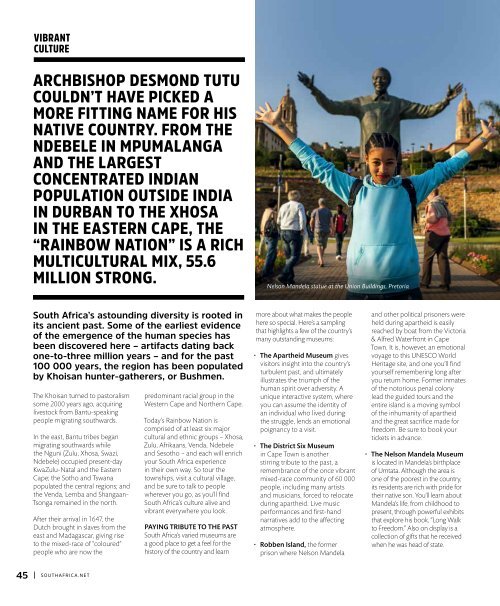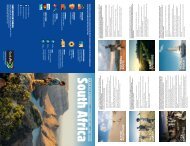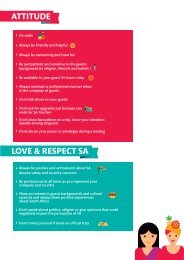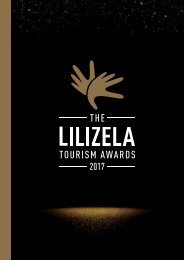USA Consumer Brochure
You also want an ePaper? Increase the reach of your titles
YUMPU automatically turns print PDFs into web optimized ePapers that Google loves.
VIBRANT<br />
CULTURE<br />
ARCHBISHOP DESMOND TUTU<br />
COULDN’T HAVE PICKED A<br />
MORE FITTING NAME FOR HIS<br />
NATIVE COUNTRY. FROM THE<br />
NDEBELE IN MPUMALANGA<br />
AND THE LARGEST<br />
CONCENTRATED INDIAN<br />
POPULATION OUTSIDE INDIA<br />
IN DURBAN TO THE XHOSA<br />
IN THE EASTERN CAPE, THE<br />
“RAINBOW NATION” IS A RICH<br />
MULTICULTURAL MIX, 55.6<br />
MILLION STRONG.<br />
South Africa’s astounding diversity is rooted in<br />
its ancient past. Some of the earliest evidence<br />
of the emergence of the human species has<br />
been discovered here – artifacts dating back<br />
one-to-three million years – and for the past<br />
100 000 years, the region has been populated<br />
by Khoisan hunter-gatherers, or Bushmen.<br />
The Khoisan turned to pastoralism<br />
some 2000 years ago, acquiring<br />
livestock from Bantu-speaking<br />
people migrating southwards.<br />
In the east, Bantu tribes began<br />
migrating southwards while<br />
the Nguni (Zulu, Xhosa, Swazi,<br />
Ndebele) occupied present-day<br />
KwaZulu-Natal and the Eastern<br />
Cape; the Sotho and Tswana<br />
populated the central regions; and<br />
the Venda, Lemba and Shangaan-<br />
Tsonga remained in the north.<br />
After their arrival in 1647, the<br />
Dutch brought in slaves from the<br />
east and Madagascar, giving rise<br />
to the mixed-race of “coloured”<br />
people who are now the<br />
predominant racial group in the<br />
Western Cape and Northern Cape.<br />
Today’s Rainbow Nation is<br />
comprised of at least six major<br />
cultural and ethnic groups – Xhosa,<br />
Zulu, Afrikaans, Venda, Ndebele<br />
and Sesotho – and each will enrich<br />
your South Africa experience<br />
in their own way. So tour the<br />
townships, visit a cultural village,<br />
and be sure to talk to people<br />
wherever you go, as you’ll find<br />
South Africa’s culture alive and<br />
vibrant everywhere you look.<br />
PAYING TRIBUTE TO THE PAST<br />
South Africa’s varied museums are<br />
a good place to get a feel for the<br />
history of the country and learn<br />
Nelson Mandela statue at the Union Buildings, Pretoria<br />
more about what makes the people<br />
here so special. Here’s a sampling<br />
that highlights a few of the country’s<br />
many outstanding museums:<br />
• The Apartheid Museum gives<br />
visitors insight into the country’s<br />
turbulent past, and ultimately<br />
illustrates the triumph of the<br />
human spirit over adversity. A<br />
unique interactive system, where<br />
you can assume the identity of<br />
an individual who lived during<br />
the struggle, lends an emotional<br />
poignancy to a visit.<br />
• The District Six Museum<br />
in Cape Town is another<br />
stirring tribute to the past, a<br />
remembrance of the once vibrant<br />
mixed-race community of 60 000<br />
people, including many artists<br />
and musicians, forced to relocate<br />
during apartheid. Live music<br />
performances and first-hand<br />
narratives add to the affecting<br />
atmosphere.<br />
• Robben Island, the former<br />
prison where Nelson Mandela<br />
and other political prisoners were<br />
held during apartheid is easily<br />
reached by boat from the Victoria<br />
& Alfred Waterfront in Cape<br />
Town. It is, however, an emotional<br />
voyage to this UNESCO World<br />
Heritage site, and one you’ll find<br />
yourself remembering long after<br />
you return home. Former inmates<br />
of the notorious penal colony<br />
lead the guided tours and the<br />
entire island is a moving symbol<br />
of the inhumanity of apartheid<br />
and the great sacrifice made for<br />
freedom. Be sure to book your<br />
tickets in advance.<br />
• The Nelson Mandela Museum<br />
is located in Mandela’s birthplace<br />
of Umtata. Although the area is<br />
one of the poorest in the country,<br />
its residents are rich with pride for<br />
their native son. You’ll learn about<br />
Mandela’s life, from childhood to<br />
present, through powerful exhibits<br />
that explore his book, “Long Walk<br />
to Freedom.” Also on display is a<br />
collection of gifts that he received<br />
when he was head of state.<br />
Robben Island, Cape Town<br />
Meet South Africa’s warm and friendly people<br />
CULTURAL<br />
ADD-ONS<br />
If you’d like to extend<br />
your cultural journey<br />
into other parts of<br />
South Africa, consider<br />
these options:<br />
• Explore the Xhosa origins of<br />
Nelson Mandela in the Eastern<br />
Cape villages of Qunu and<br />
Umtata.<br />
• Journey deep into Limpopo to<br />
the Modjadji Nature Reserve,<br />
near Tzaneen and visit the village<br />
of the Rain Queen.<br />
• Visit artistic Clarens and get a<br />
deeper understanding of what<br />
the real lifestyle of the South<br />
Sotho people is like in the<br />
Basotho Cultural Village.<br />
• Pay your respects to the King of<br />
the Zulus at the monument of<br />
Shaka Zulu in KwaZulu-Natal.<br />
• Enjoy the colorful paintings and<br />
beadwork of the Ndebele people<br />
with a visit to Botshabelo in the<br />
Mpumalanga province.<br />
45 | SOUTHAFRICA.NET<br />
SOUTHAFRICA.NET | 46








